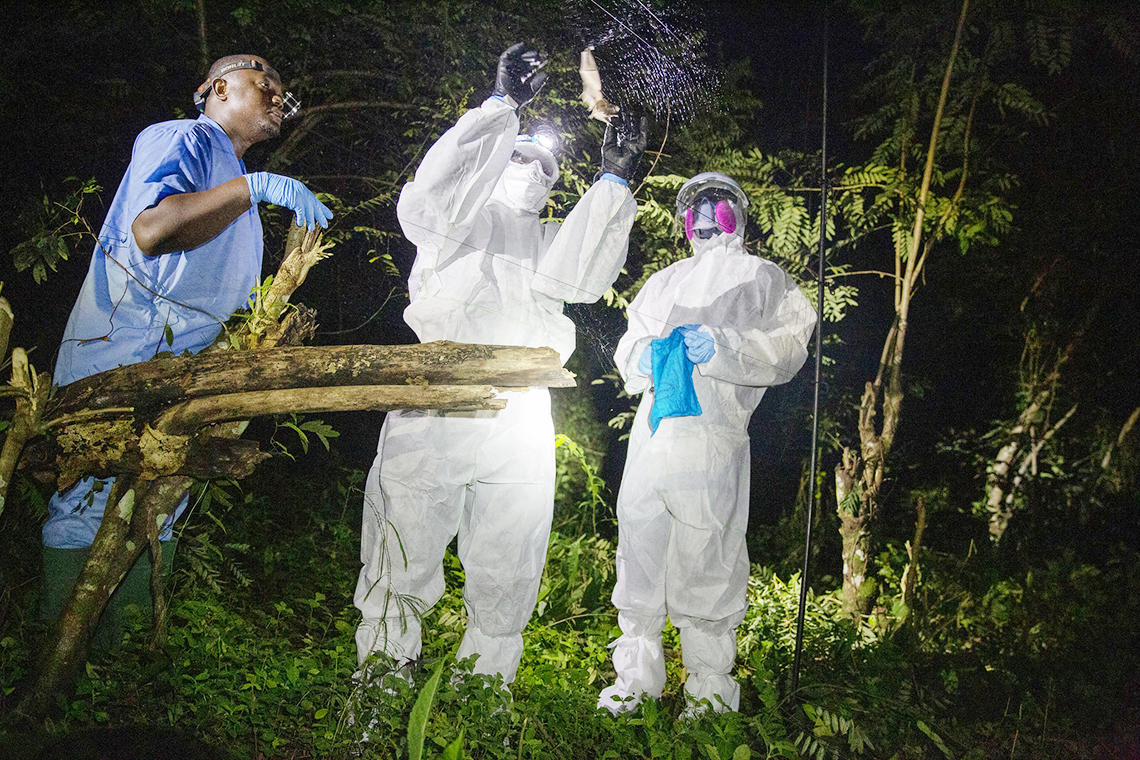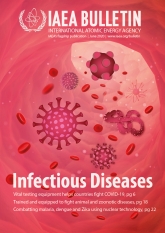To achieve a high level of surveillance, scientists study the bat species in their natural, wild habitat. This entails getting their hands dirty, both figuratively and literally.
“It’s not easy. To diagnose and identify a virus, you need a high-quality sample, taken properly and shipped the right way,” Unger said, explaining that, to capture a bat, a team of at least six people must enter the jungle during daylight, set up poles and nets to make traps, and wait until dark for the first bats to appear.
The idea is to cause as little disruption as possible to the ecosystem. As bats are nocturnal mammals, the virus hunters work at night, respecting the animals’ rhythm.
“Bats come out at night, so that’s when we can get them. We catch them and then later return them to the wild,” said Temidayo Adeyanju, a wildlife researcher from Nigeria and a lecturer at training courses supported by the Joint FAO/IAEA Division, where participants learned about different bat-capturing methods according to habitat types and bat species.
After the vets, forest rangers and wildlife specialists trap the bats, they return to the lab, where the animals are identified, measured and probed for blood, faecal and oral samples in order to analyse any of the hundreds of viruses they can transmit to animals and humans, including the Ebola virus. To do this, they use nuclear-derived techniques and equipment donated through the IAEA technical cooperation programme.
“In Togo, we didn’t even dare to touch bats for sampling because we didn’t have the skills. But now we do, and we ought to. We cannot let our guard down,” said Komlan Adjabli, an animal scientist from the Livestock Directorate of Togo, who in 2018 attended the second in a series of training courses supported by the Joint FAO/IAEA Division.
Despite the stigma surrounding bats, they are key to the ecosystem, said Adeyanju. “They’re strange creatures. They come out at night, they eat insects or fruits, and people are scared of them. But if you take out the bats, you affect all the other species. They are a keystone.”
While bats play a vital part in ecosystems, they also continue to carry threats to people; every year, around ten new viruses are discovered in bats. Among these are viruses like the Ebola virus, which can be transmitted through close contact with infected bats’ blood, secretions, organs or other fluids.
“People are scared of Ebola,” said Hawa Walker, a conservation specialist from Liberia, the country neighbouring Sierra Leone that also suffered from the epidemic in 2014. “They are obsessed with washing their hands and cleaning their houses. But in many households, bats are still food. They’re a source of life for those who have no other choice.”
Training courses organized through support from the Joint FAO/IAEA Division are part of efforts to help African veterinary and wildlife scientists to join forces and, through active disease surveillance, anticipate or even prevent outbreaks in the region.
“We need a holistic approach to health,” said Michel Warnau, an IAEA project manager who oversees these courses. “One of the issues during the Ebola outbreak in West Africa in 2014 and 2015 was the lack of preparedness. Through these courses, we want to build capacities to study and diagnose zoonotic diseases in livestock and wildlife before an outbreak occurs, in order to better anticipate risks to human populations.”




